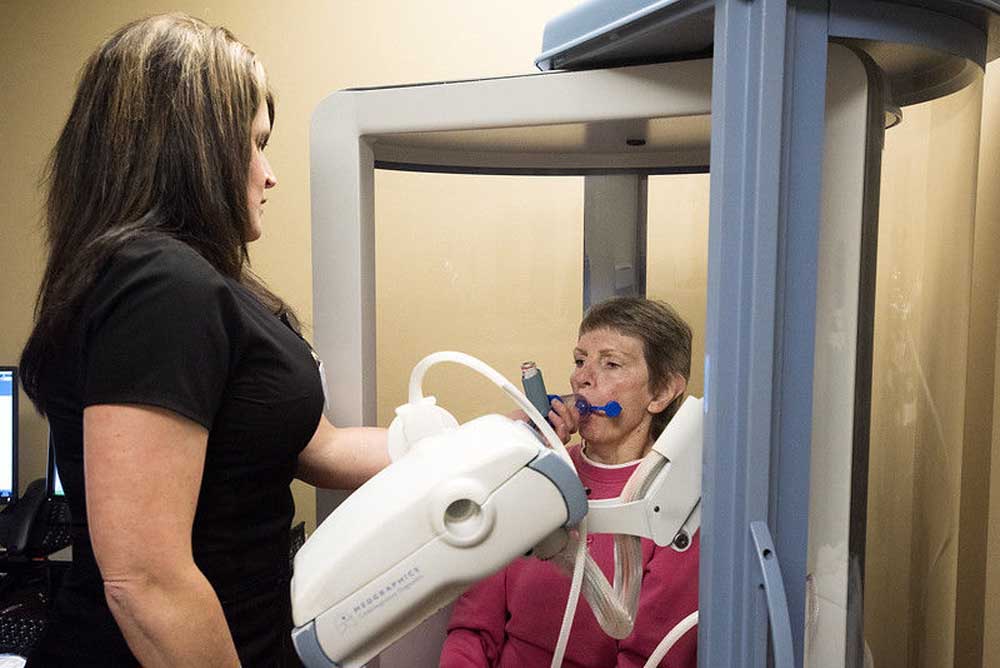Christus’ Pulmonary Medicine Center at Louis & Peaches Owen Heart Hospital provides for diagnose, maintenance of COPD
Published 4:16 pm Friday, November 24, 2017

- Leslie Taylor assists Rosalie Howerton with a pulmonary function test at Christus Trinity Mother Frances' Pulmonary Medicine Clinic in Tyler, Texas, on Monday, Nov. 20, 2017. (Chelsea Purgahn/Tyler Morning Telegraph)
Rosalie Howerton, of Tyler, took deep breaths and then blew into a machine in the Pulmonary Medicine Center of Christus Trinity Mother Frances Louis & Peaches Owen Heart Hospital.
The pulmonary function tests, she said, “are very difficult … they are hard to do.”
The center has two rooms where the tests are administered to about 20 patients a day. The tests are necessary for diagnosis and maintenance care of chronic obstructive pulmonary disease.
Ms. Howerton did not know that she has COPD until doctors told her back in April. In addition to having Level 1 COPD, she has had lung cancer and doctors removed her right upper lobe in June.
COPD is a gradually progressive lung disease and the third most common cause of death behind heart disease and cancer.
November is designated as COPD Awareness Month to bring awareness to the fact that COPD is a treatable disease, a Tyler pulmonary physician said.
“The sooner people are diagnosed, the better their prognosis is,” said Dr. Jeffrey Shea, of Christus Trinity Clinic Pulmonary Medicine Center.
“You can stop it where it is when it is diagnosed and treat it, but you can’t cure it,” Shea said. “You can live with COPD for decades. The more progressed the disease (is when diagnosed), the worse it’s going to be.”
The term COPD refers to emphysema and chronic bronchitis.
The most common symptom of emphysema is shortness of breath. The main symptoms of chronic bronchitis are a chronic cough and production of sputum. With emphysema, holes destroy the lungs. Chronic bronchitis is a bronchial inflammation.
About 1 million Texans and 11 million Americans live with COPD, according to the American Lung Association.
There is concern that a lot of people may have undiagnosed COPD, Shea said. Although about 5 percent of the population in Texas has been diagnosed with COPD, he said, it’s thought at least that many more are undiagnosed at this point.
Shea advised anyone with symptoms to get tested to see if they have COPD or some other cause for their malady.
Treatment primarily involves stopping the cause of COPD, Shea said.
The most common cause is smoking, the physician added, but noted some occupations are associated with COPD because of dust particles that people come in contact with while doing those jobs.
COPD patients are advised to stop smoking if their condition is related to smoking or to avoid things in the environment that might have caused it.
If COPD goes undiagnosed and the patient does not change their behavior, the disease will get worse, Shea said.
COPD can be diagnosed with breathing tests that measure air flow. Patients blow hard into a machine. The pulmonary function test measures patients’ lung capacity. Doctors compare their air flow with what it should be to determine if their lung capacity has decreased.
“Patients with COPD almost always have obstruction to air flow,” Shea said. “That tells us not only that they have the disease, but it also tells us how bad it is. We use the numbers to say patients have mild, moderate or severe disease.”
COPD is irreversible, according to Shea.
“Once you get it, you’ve got it,” he said. “From there, it’s a matter of managing the disease.”
For the treatment of COPD, Shea said, “We use inhale medicines called bronchodilators. These are medicines patients inhale that hit receptors in the airways that help to relax the muscles that may be causing spasms in the airways to try to improve their air flow.”
If the air flow improves, Shea said, then COPD patients cough more effectively to clear out secretions and mucus. The mucus by itself increases the risk of shortness of breath and symptoms of shortness of breath, but also is part of the reason why COPD patients get infections more often. With removal of the mucus, breathing improves and the risk of infections go down.
Sometimes physicians use steroids or co-steriod pills to treat COPD, particularly when patients have attacks or exacerbations, Shea said. In those situations, patients wheeze a lot and are very short of breath. “This is one of the more common reasons why they end up in the emergency room,” he said.
Antibiotics are also used during the attacks since most of them are related to infections, Shea said. Some data suggests that use of chronic antibiotics in COPD patients who have attacks frequently can decrease the number of episodes that they have.
“We think that the more attacks that they have, the faster their lung function has worsened. A main part of what we (doctors) do to treat them is to try to prevent attacks that they have,” Shea said.
An extreme level of treatment for emphysema involves removing very damaged lung areas so that the good part of the lung can expand out and that helps with shortness of breath, Shea said.
The most extreme level of treatment for patients with very severe emphysema is a lung transplant, the physician said.
A formal pulmonary rehab program is available for COPD patients who have significant symptoms to help them become less short of breath, Shea said.
Part of the program teaches them how to breathe … for example, lip breathing where they breathe in through their nose and blow out through pursed tight lips.
“That helps to keep the airways opened up so more air can get out of the lungs,” Shea said.
When the lung is damaged enough, doctors use oxygen therapy.
“Oxygen has been shown to prolong survival for people with very severe COPD,” Shea said.
TWITTER: @Tylerpaper






